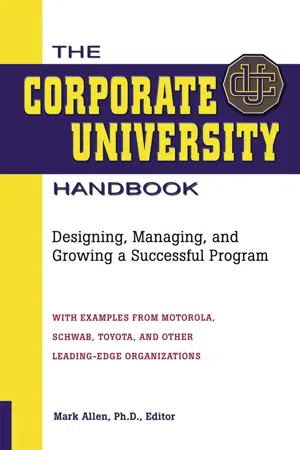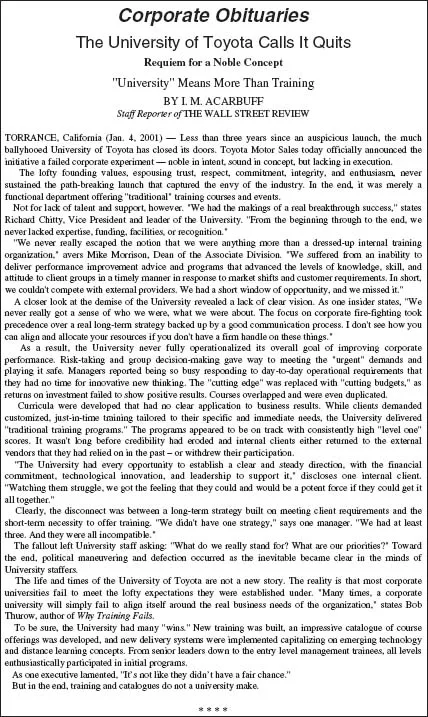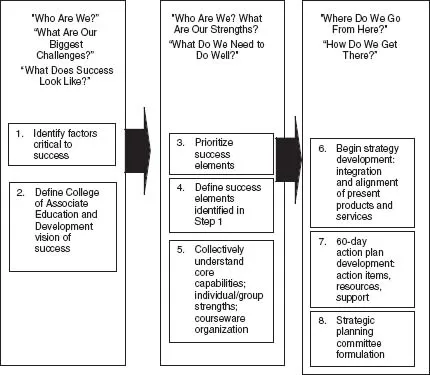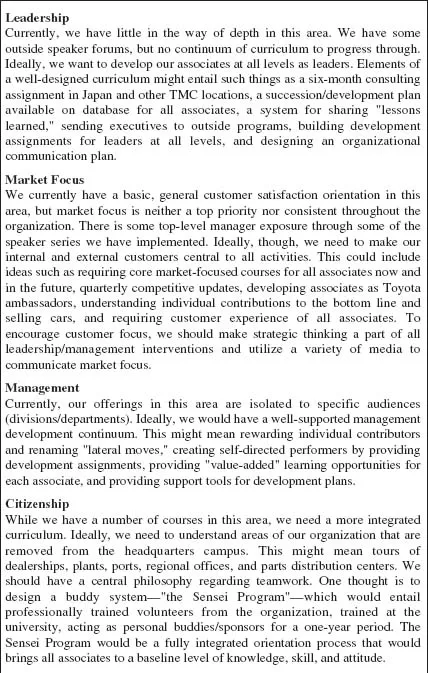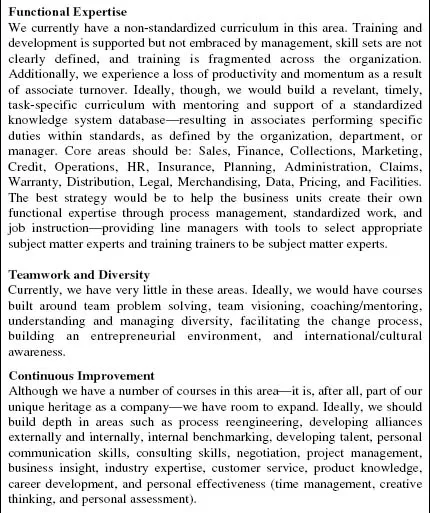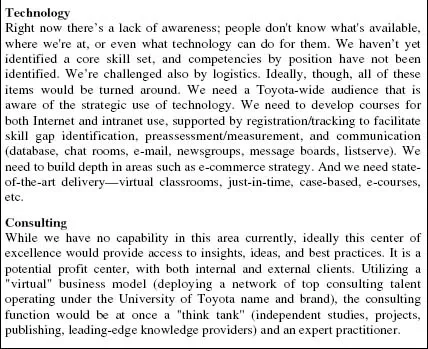![]()
Designing a Corporate University
![]()
Creating a Corporate University: Diary of a Launch
Mike Morrison
The University of Toyota, headquartered in Torrance, California, was officially approved by Toyota Motor Sales, USA, Inc., in 1998. The university was one of several corporate initiatives that emerged from Toyota's New Era Group, whose charter was to design strategies that would enhance Toyota's competitiveness in the new millennium. The University of Toyota is a distinct business unit independent of the human resource and organizational development departmental functions. Built on the values of trust, respect, integrity, commitment, and enthusiasm, the University of Toyota has a stated mission “to continuously improve associate and dealer performance through lifelong learning.” This is accomplished through two colleges: the College of Dealer Education and Development and the College of Associate Education and Development. The university now serves the global Toyota organization. This chapter is an account of our beginnings at the University of Toyota—a tale intended both to tell the story of our journey and to provide some guidance to those who are on the verge of or already in the process of creating a corporate university.
Journal Entry, December 1, 1998
We've officially been a university for several months now, but I'm beginning to get nervous. I have a fairly clear vision of the university's future, and I want to move forward quickly. Yes, we have a mission statement and a set of values—our brochures say so! My point here is that these things, while they all sound right and are directionally good, were all born out of the need to internally market the launch of the University of Toyota. They aren't known by my staff, so they certainly aren't shared. Part of my challenge is that we're so new that we don't even know each other—a challenge that is heightened by the fact that we're housed in a number of locations around the company and around the country.
As I think about it, I need to get my arms around a number of things:
- A strategy to move us beyond a centralized training function to a unique corporate university organization
- A means of building a true team and organizing my staff
- A strategy for identifying and structuring our real “centers of excellence”
- A means of organizing and aligning our current and future curricula to ensure quality service to our “customers”
- A way to transform our loose collection of courseware into well-purposed, well-integrated curricula
- Some way to give my team input into and ownership of our direction and my vision
- As the bottom line, a shared understanding of who we are (individually and as a team), what our strengths are, where we're headed, and how we're going to get there
In short, I need a plan for the future.
Journal Entry, December 15, 1998
I have decided to bring the entire team together for a three-day off-site strategic planning session immediately following the New Year. I need a plan to make those three days as productive and engaging as possible. I have thirty people reporting to me, so it'll be no easy challenge. In my mind, I have three primary objectives:
- Build a collectively designed vision of the future for the College of Associate Education and Development
- Develop an initial curriculum direction and integration strategy
- Enhance teamwork and camaraderie
I realize that I need to enlist some independent help. I set a full-day design meeting with a consulting partner. We'll have to meet over the holiday when Toyota is “dark.”
Journal Entry, December 29, 1998
Today was a good day. Design day. Good meeting. I'm fairly confident that our agenda will work. Design Challenge #1 was to create a mechanism to immediately focus the energy of the team on the issues that will define and determine our success as a corporate university—some creative way to elicit input in a positive way with an eye toward finding out what's possible.
Our creative device: a fictitious “Wall Street Journal-like” newspaper exposé set three years in the future (see Figure 1-1), with the various issues embedded. This will enable us to construct a master list of critical success factors. Additionally, it will serve as a visioning exercise, as the assignment will be to rewrite the headline and first paragraph of the article—in essence, to paint the picture of the future. As I see it, we have to overcome a number of critical, potentially crippling obstacles.
First, we need to transform ourselves from a loose-knit, decentralized provider of corporate training and education to a cohesive provider of performance improvement solutions with the ability to design, develop, and deliver interventions that will have impact. The focus on lifelong learning and performance improvement is what will elevate us to university status, beyond being merely a catalog of courses.
Second, we will have to overcome the fairly entrenched notion that we have no new capability, only a new name. We need to be the provider of choice. In effect, we will be competing with independent vendors. Our products and services must be world-class.
Figure 1-1.
Finally, we need to ensure that we are able to link strategically to the business goals and objectives of Toyota. By that I mean that we need to show our impact on business results.
The general process for the meeting is shown in Figure 1-2. The meeting is designed to be highly interactive and self-directed, with several facilitators, including myself.
Journal Entry, January 4, 1999
Day One of the off-site meeting is in the can, and it was successful. As I expected, we had to overcome some initial skepticism. But by the end of the day, I sensed a growing feeling of unity. We split the larger group into rounds of five, and teamwork grew as people got to know one another.
Figure 1-2.
The fictitious article worked! The team identified a number of factors, all of which address my own concerns:
- Clarity in values. What are we? Who are we? What are our beliefs, our norms? Does our mission statement capture our purpose fully? What does “lifelong learning” mean? What do we bring to the party to add value?
- Shared vision. What is our picture of the future? What are our goals? What does it look like when we meet those goals? How do we treat one another? How does our mission support Toyota's?
- Client focus. Whom are we serving? At what levels? Are we responding to their requirements? How are we serving them now? How should we be serving them? How are we structured to serve them? Are we aligned correctly to do so? What are their real and perceived needs? How do we assess those needs?
- Unified strategy. How do we achieve our mission/vision? What are our priorities? What are our core competencies, our centers of excellence? What are our products and services? What are our curricula and courses? How and where are we aligned and integrated?
- Alignment with business results. What are the business goals of the College of Associate Education and Development? Are we aligned correctly? Are the goals achievable?
- Operational consistency. How does our work get done? What are our core processes (e.g., efficient communication)?
- Measure of success in performance improvement. How will we know if we're successful? What evidence is needed? How do we hold ourselves accountable?
The rewritten story is worthy of capturing (see Figure 1-3).
Journal Entry, January 5, 1999
Day Two down…and a long one at that. But it was highly productive: We prioritized and defined our output from Day One, and we began to get a real sense of our curricula.
Figure 1-3.
The group came to the consensus that really only two primary success element categories existed: (1) values/mission/vision and (2) a unified strategy addressing client focus, operational efficiency, and personal development (see Figure 1-4).
The next step was to define these elements. Having already agreed on the vision of our future, the group unanimously agreed that our purpose, or mission, was in fact as we had stated already:
“To continuously improve associate performance through lifelong learning.”
Figure 1-4.
It remains my personal goal to arrive at a unique definition of lifelong learning, far beyond something that simply means “continuous study.” Our unique identity will hinge on a conceptual model that ties our purpose and values to our products and services.
The group also confirmed that our stated values—trust, respect, integrity, commitment, and enthusiasm—provided the principles to which we could turn in making critical decisions.
The more detailed work revolved around defining the three pillars of a unified strategy. The first element of that strategy, client focus, was defined as encompassing seven key components:
- Clear client definition (divisions, business units, audiences)
- Clear needs definition (via consultative assessment)
- A clear performance improvement process and plan (consulting model)
- Courseware aligned with desired Toyota business results
- World-class delivery (methods, materials, faculty)
- Measurement (evaluation at all levels)
- Catalyst for strategic alliances (become a true partner in performance)
The second strategic element, operational efficiency, was defined around five tenets:
- Effective communication (internal communication, external communications, shared meetings, full utilization of available technology)
- Technology systems (delivery systems, registration, tracking, measurement)
- Curriculum development (quality standards)
- Self-directed learning environment
- Consistent/rigorous project management
The third strategic element, personal development, focused on ensuring our performance improvement capability. This meant developing our skills related to consulting, consultative selling, project management, needs assessment, business updates, learning technology, process consulting, and facilitation.
It remained to get a sense of where our individual and group strengths were, and how we should begin to think about organizing our courses.
The group completed course descriptions for more than seventy-five current courses. Forms detailing the course name, audience, content, vendor support, delivery system, evaluation, and other factors for each course were posted around the room, arranged according to client and business unit. Individual “talent” sheets were also completed by individuals and posted, in an effort to communicate and identify expertise.
At the end of the day, I gave a presentation that offered my suggestions for aligning what I thought should be our core capabilities. I proposed ten core capability centers, or “centers of excellence”:
- Leadership
- Market focus
- Management
- Citizenship
- Technology
- Teamwork
- Diversity
- Functional expertise
- Continuous improvement
- Consulting
This set us up for the final day.
Journal Entry, January 6, 1999
The final day was a home run. We spent the majority of the day conducting a significant gap analysis, alignment, and integration exercise. The challenge would be turning the great ideas into action.
First, current courses were mapped to the ten core capability areas to identify gaps and begin the process of integration and alignment. This was done by rearranging the course descriptions, moving them from client/business units to the ten core capability areas. This allowed a visual display of the product/service deficiencies and the general lack of integration and consistency in the core areas.
We then assigned two of the ten capability areas to each of the five teams. We charged each team with the task of identifying the current and ideal states of their designated core capability areas, in an effort to assess gaps and needs.
I was impressed with the teams’ output. The visions for the various centers of excellence were well thought out and are worth noting here; they are given in Figure 1-5.
The real work then began—developing sixty-day action items focused on the team-developed gap analyses and “ideal states” and identifying the support and resources needed to accomplish those action items.
At the end of the day, we had ten 60-day action plans—a lot of work to do and not a lot of time to do it. This begged the question, Who would implement these plans?
The need for a strategic planning team consisting of one point person for each area of core capability was apparent. The team would be charged with integration, alignment, and curriculum review, much like a true university planning committee. I explained the requirements and requested that volunteers respond to me personally within twenty-four hours.
Our launch meeting concluded with the team members sharing personal reflections with the large group. Based on the heartfelt affirmations offered by each team member, I am confident that the next sixty days will bring us much closer to my envisioned future for the University of Toyota.
Figure 1-5.
Journal Entry, March 1999
Things have been moving incredibly fast. In two short months, we have completed the first attempt at our organizational structure and fleshed out the implementation of our performance improvement approach. We have also started to think about how best to internally market the university.
We have decided to organize ourselves around six key centers of excellence, down from the original ten. Given the realities of the broader organization, these centers have a hybrid focus—a mix of subject matter, function, and audience. I plan to have an associate dean for each center.
These plans are not carved in stone by any means, but this is what we're thinking:
- Center for the Toyota Way—to provide learning that helps each Toyota associate become a Toyota advocate and citizen for life.
- Center for Management Effectiveness—to provide learning that enables managers to better mobilize people and resources and to align them with the business goals of the organization in the most productive manner.
- Center for Personal and Professional Effectiveness—to provide the learning needed for associate self-discovery in the areas of both personal and professional development.
- Center for Technology Learning—to provide learning that helps all associates maintain, update, and expand their current personal computer skills, with the goals of ensuring not only personal and professional productivity, but also future employability.
- Center for Automotive Business Operations—to provide a broad base of knowledge in all areas of automotive business operations, including corporate operations such as marketing, sales, service and parts, and customer service as well as retail operations.
- Center for Executive Leadership—to provide learning that helps our executives and high-potential managers prepare themselves to lead our organization into new ways of thinking and new ways of doing business.
We have identified each major business unit within the Toyota organization, and we have decided to assign a business unit liaison to each unit. This is our strategy for achieving both a client focus and a performance improvement approach.
Business unit liaisons have two primary functions: (1) they serve as the primary resource contact for associates who wish to take advantage of our curricula; and (2) they serve as performance improvement consultants, assisting the business units in systematically analyzing problems and determining how education and development can support their key business goals. This is in keeping with our philosophy that a corporate university must transcend the traditional notion of corporate training and education—it must focus on performance improvement and consulting, rather than just filling training requests. Additionally, it furthers one of our fundamental goals: to align education and development with the strateg...
